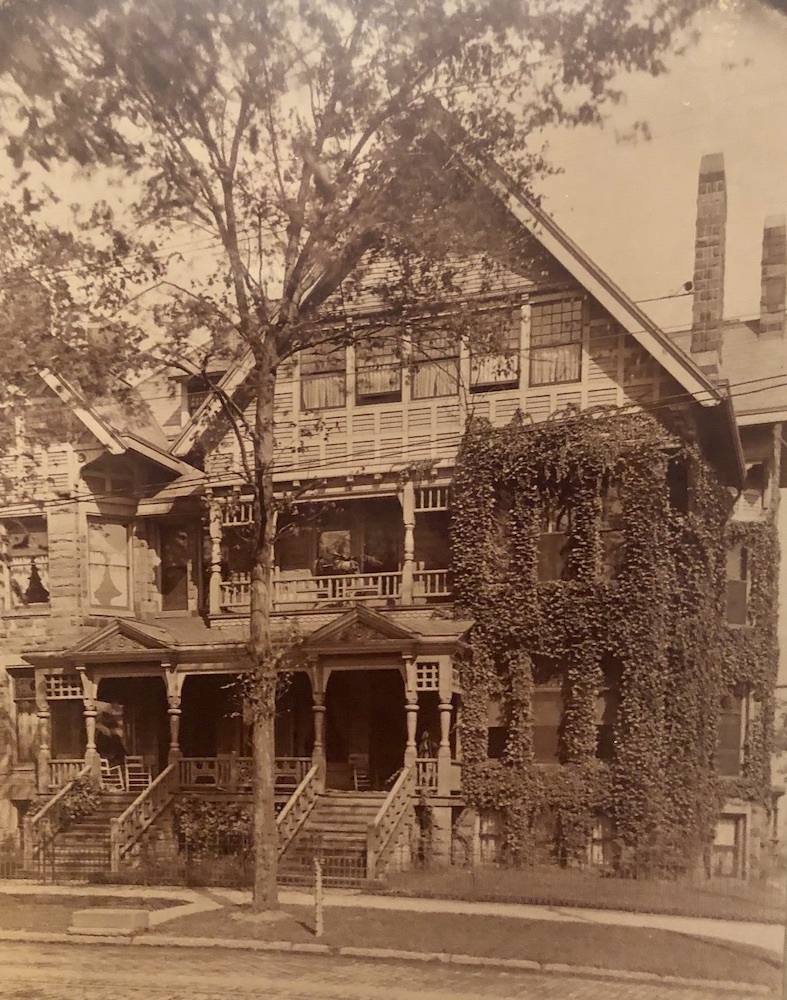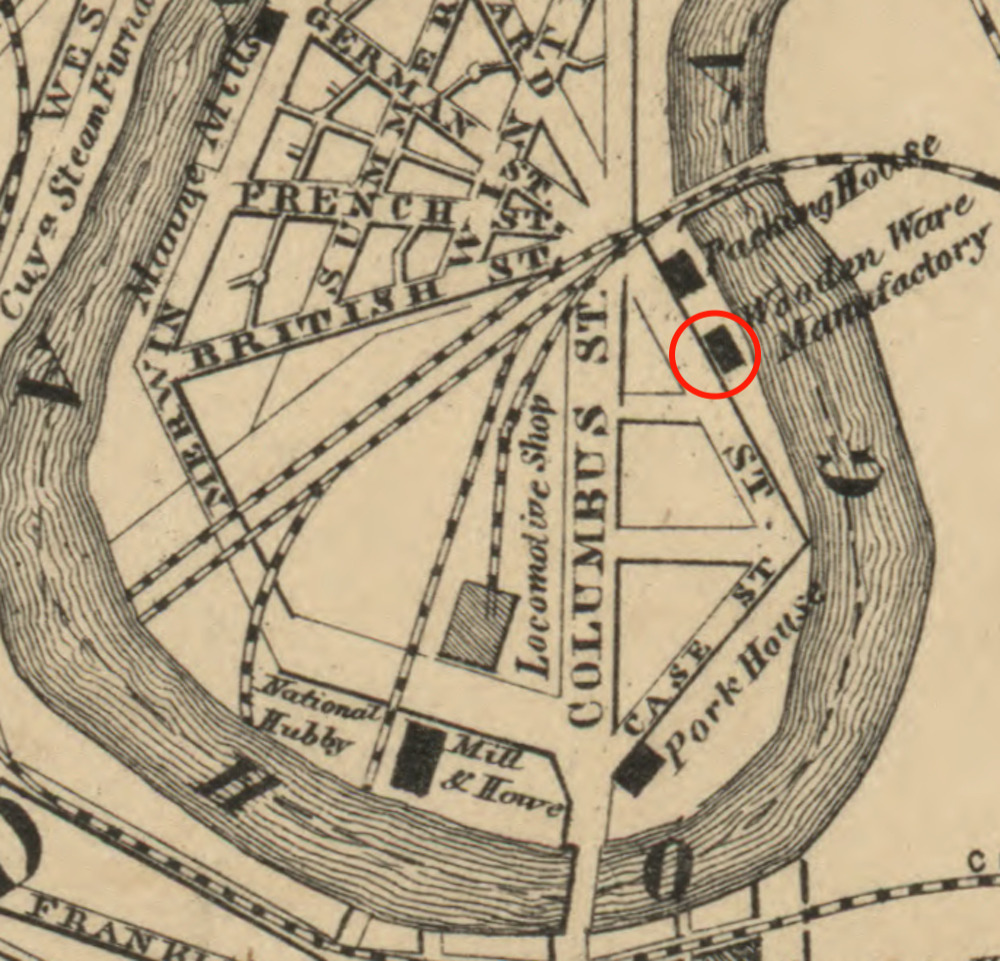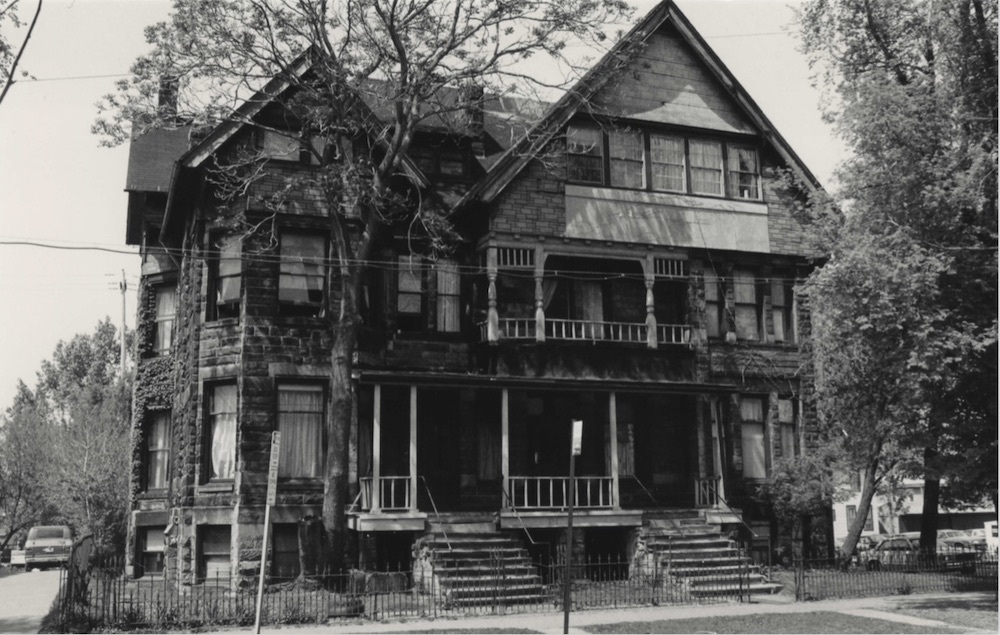
Wealth generated from John Bousfield's wooden ware business enabled the Bousfield family to move into their first house on Franklin Avenue in 1863. After the business failed and they lost that house, the resilient Bousfields found a way to return to the west side's "Euclid Avenue" in 1883, building the mammoth stone house that today still stands at Franklin Boulevard and West 38th Street.
The large stone house on the northwest corner of Franklin Boulevard and West 38th Street was built in 1883-1884 for John and Sarah Bousfield. It was designed by the prominent nineteenth century architectural firm of Coburn and Barnum, the same firm that designed the Spitzer-Dempsey House at 2830 Franklin Boulevard. The house, which today has the address of 3804-3806 Franklin, was designed to be a two-family home with the Bousfields occupying the larger east side, which was advertised as having 17 rooms, and a renter occupying the west side which was said to have 13 rooms. The house is two and one half stories tall and has more than 12,000 square feet of living space. It also has a full basement with ground level access from the back yard. The house was designed in the Queen Anne style, with characteristic asymmetrical massing, half-timbered gables, and what local architectural historian Craig Bobby referred to as "robust" spindlework. Bobby also opined that the design of the house is closer to the English example of this style of house and less "Americanized" than other Queen Anne style houses built in Cleveland in the late nineteenth century.
John Bousfield and Sarah Featherstone, the house's original owners, were English immigrants who came to America in the early 1840s. They met in Kirtland, Ohio, and married there in 1845. After having little success in trying his hand at farming, John purchased a small wooden ware business and began manufacturing wooden pails, first in Kirtland and then in nearby Fairport (today, Fairport Harbor). Looking for a better location for his business, he moved his family to Cleveland in 1855. His early years working and residing in the city were filled with a mixture of small successes and several business reverses, the latter often caused by fires that appear to have been altogether too common in the nineteenth century wooden ware manufacturing industry. However, by the early 1860s, he and his business partner J. B. Hervey had established a large and successful business, known as Cleveland Wooden Ware Manufacturing Company, in Cleveland Centre, near the intersection of Leonard and Voltaire Streets. After Hervey retired from the business in 1866, Bousfield and his new partner John Poole had even greater success initially, growing the business into what several contemporary sources stated was the largest wooden ware business in the country. By this time, the company was manufacturing not only wooden pails, but also many other wooden products used in that era, including churns, half-tubs, washboards, clothes pins, dressed lumber, shingles, mouldings, and matches.
Befitting John Bousfield's business success, the Bousfield family in 1863 moved from a house on Pearl (West 25th) Street into their first house on Franklin Avenue (Boulevard), a grand mansion built in the Italianate style and located on the southeast corner of Franklin and Duane (West 32nd) Street. To their east lived William Castle, former mayor of Cleveland, and to the west their house was just a stone's throw away from the Kentucky Street Reservoir and its legendary promenade walk. (Diagonally across Franklin on the corner of State Street they may have noticed the little girl who tended to her flower garden and often played with Mayor Castle's daughter. She would grow up to become Ella Grant Wilson, one of Cleveland's pioneer feminists.) Living on Franklin Avenue, the Bousfields interacted socially with many of the west side's wealthiest families, including those of Daniel Rhodes, John Sargent, Nelson Sanford, Belden Seymour, Thomas Axworthy, Judge James Coffinberry and his son Henry, and George Warmington, just to name a few. One such interaction, which was described in an article that appeared in the Cleveland Plain Dealer on January 8, 1870, was the party the Bousfields threw for their 25th wedding anniversary, where their "spacious mansion . . .on Franklin Street . . . was thronged with guests." Interactions like these were not only "social," but often also presented opportunities for neighbors on the west side's "Euclid Avenue" to form new or cement old business relationships with each other. John Bousfield was involved in several such business relationships with his neighbors. In 1866, he and neighbors Daniel Rhodes, Nelson Sanford, John Sargent, James Coffinberry, and others, had founded the People's Gas Light Company, which Bousfield later headed as president. Three years later, in 1869, he participated in the formation of the People's Saving and Loan Association, serving for the next six years as one of the bank's two vice presidents under president Daniel Rhodes. Despite all of his neighborhood social and business successes, however, the economic depression in the United States that followed the Panic of 1873 may have been too much to overcome. John Bousfield's wooden ware business in Cleveland Centre collapsed in 1875 and he was left bankrupt, losing not only his business assets to creditors but, in 1880, his grand house on Franklin Avenue too.
After his business failed in 1875 and he lost his house on Franklin Boulevard, John Bousfield started a new wooden ware manufacturing business at a different location on the west side with help from his adult children, including his daughter Charlotte who lived with him and Sarah, but it was plagued by fire, lawsuits and other problems. By 1881 it had closed and its business operations had been transferred to his adult sons' wooden ware manufacturing facility in Bay City, Michigan. Between 1880 and 1883, the Bousfields rented a house on nearby Clinton Avenue--literally within sight of their former mansion--while they strove to satisfy creditors and plan their return to Franklin Avenue. While there, they purchased another house on the northwest corner of Franklin and Kentucky (West 38th) Street in 1881. They rented that house out until 1883, when they either razed it or moved it to make room for the large stone mansion designed by Coburn and Barnum that was subsequently built on the corner. In the same year that the stone house was completed, the Bousfields began renting out rooms in a second house on the property that fronted Kentucky Street. (This house may have been all or part of the house that formerly sat on the corner of Franklin and Kentucky; it may have been new construction; or it may have been a house that was moved from another location.) With two houses on their lot, the Bousfields were not only able to generate rental income from the west side of the stone mansion, but also from the second house too. While there exists little evidence of the financial status of John and Sarah Bousfield during this period, the rental income from these properties may well have been critical to their survival in what were the later years of their lives. John Bousfield died at the house in 1888; his wife Sarah died there six years later in 1894.
Following their deaths, Horace Hannum who lived up the street and who married Charlotte Bousfield just months after her mother's death, took over the management of the Sarah Bousfield House as well as the other house on the property. Hannum maintained the west side of the Sarah Bousfield House as a single-family unit, moving into it with Charlotte in 1898 and living there until his death in 1908. The larger east side of the house, however, was by 1900 operating as a rooming house. Shortly after Horace's death, Charlotte and the other heirs of Sarah Bousfield sold the property in 1910 to Juno Robeson, a social worker who had moved to Cleveland ten years earlier from Paducah, Kentucky. Robeson converted the entire stone mansion into a rooming house for businesswomen. It may have been during her ownership (1910-1923) that physical alterations were made to the house to provide access from one side of the house to the other. Robeson's Business Inn for Women does not appear to have survived for more than a couple of years. Thereafter the stone mansion, as well as the other house on the property, like many other large houses on Franklin Boulevard in the twentieth century, became rooming houses, first managed during Robeson's ownership, and then later directly owned, by Frank and Clara Bennett. By 1925, the stone mansion was being advertised for lease as a rooming house with 38 rooms. Both houses on the property remained rooming houses for much of the rest of the twentieth century. In 1945, the lot upon which the two houses sat was split and the houses were thereafter under different ownership. While it is unclear exactly when, at some point in time after 1966 the other house was razed. The resulting vacant lot afterwards became property of the city of Cleveland which, in 1983, sold it to the Franklin Boulevard Nursing Home, located across West 38th Street from the Sarah Bousfield House.
And thus the stone mansion continued to sit on the corner of Franklin Boulevard and West 38th Street, continued to be used as a rooming house, and continued to deteriorate until 1994, when James Hauer and Richard Turnbull purchased it at a sheriff's sale. The two men had since 1988 owned and lived in a house up the street at 3901 Franklin Boulevard. Turnbull, an art historian, wanted to restore and renovate the house, redividing it into its original two-family configuration, with four apartment suites on the east side of the house and a five-room bed-and-breakfast on the west side. After hiring Cleveland architect John Rakauskas, obtaining city approval for their plan, and providing financial incentive for their roomers to vacate the house, Hauer and Turnbull began restoring and renovating it in 1999. (That same year, they also purchased the vacant lot owned by the nursing home in order to provide parking for tenants and guests.) Turnbull conducted extensive research in the restoration effort. He located a 1905 photo of the house to guide his restoration of its exterior. Decades of paint were hand-scraped off the house to get down to the original colors. The front porch was restored with its original columns carefully replicated. In the interior of the house, walls that had been put up to create the rooming house were removed, and the original rooms, to the greatest extent possible, were restored, even down to moldings and picture rails. (During the renovation, Turnbull was able to debunk a legend told to him by a former roomer that in the 1950s money from a bank robbery had been hidden somewhere in the house under a floorboard. Roomers believing the legend had cut through many of the house's floorboards, sometimes even switching rooms to cut through more. If the money had ever been in the house, it was long gone before Trumbull did his extensive renovation.) The total cost of the renovations and restoration was $650,000. The majority of the work was completed in 2001, when Stone Gables, a bed-and-breakfast that was advertised as a safe place for gay visitors to stay in Cleveland, opened. Remaining work on the house continued for two more years before the renovation and restoration was complete. Hauer and Turnbull operated the bed-and-breakfast and rented out the apartments in the house until 2017, when they sold the house. As of 2021, its new owners continue to operate the Sarah Bousfield House--still also known as Stone Gables--as Hauer and Trumbull had.
Images

















